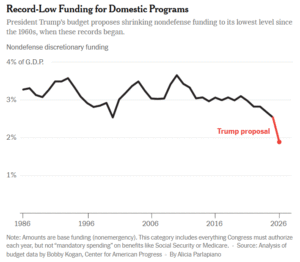The New York Times article quoted below worried that if Vivek Ramaswamy succeeded in “slashing regulation” of drugs, his own drug development firm would have benefitted. Maybe so, but that misses the main point–all the rest of us also would have benefitted by medical entrepreneurs being allowed to create more and quicker cures. Presumably The New York Times was relieved when Ramaswamy resigned from DOGE, but I was discouraged.
I was in favor of Elon Musk’s push to reduce the number of federal employees. But I was even more in favor of Vivek Ramaswamy’s push to deregulate innovative entrepreneurs.
[By the way, isn’t it predictable that The New York Times delights in highlighting Roivant’s one failure, but gives only passing scant mention to its six successes?]
(p. A10) Vivek Ramaswamy is the less famous and less wealthy half of the duo of billionaires that President-elect Donald J. Trump has designated to slash government costs.
. . .
At 39, he is one of the world’s youngest billionaires, having made his fortune in the pharmaceutical industry. . . .
Mr. Ramaswamy, who owns a stake currently valued at nearly $600 million in a biotechnology company he started, has called for changes at the Food and Drug Administration that would speed up drug approvals.
. . .
Since being named to jointly lead DOGE, Mr. Ramaswamy had until recently been posting on Mr. Musk’s social media site X, hinting about where he may look to make changes in the government.
He called for slashing regulation, not just cutting government spending. He pointed to federal workers focused on diversity as potential targets for “mass firings.”
And he has been taking aim at the F.D.A. “My #1 issue with FDA is that it erects unnecessary barriers to innovation,” he wrote on X. He criticized the agency’s general requirement that drugmakers conduct two successful major studies to win approval rather than one.
Mr. Ramaswamy founded his biotechnology company, Roivant Sciences, in 2014, betting that he could find hidden gems whose potential had been overlooked by large drugmakers. The idea was to hunt for experimental medications languishing within large pharmaceutical companies, buy them for cheap and spin out a web of subsidiaries to bring them to market.
The venture is best known for a spectacular failure.
In 2015, Mr. Ramaswamy whipped up hype and investment around one of his finds, a potential treatment for Alzheimer’s disease being developed by one of his subsidiaries, Axovant. Two years later, a clinical trial showed that it did not work, erasing more than $1.3 billion in Axovant’s stock value in a single day.
Mr. Ramaswamy personally lost money on paper on the failure, but thanks to the savvy way he had structured his web of companies he and Roivant weathered the storm. Six products have won F.D.A. approval, and today Roivant has a market valuation of $8 billion.
Mr. Ramaswamy sold some of his Roivant stock to take a large payout in 2020, reporting nearly $175 million in capital gains on his tax return that year. But he is still one of the company’s largest shareholders.
If Mr. Ramaswamy recommends changes that speed up drug approvals through DOGE, that could be good news for Roivant, which is developing drugs that might come up for approval during Mr. Trump’s second term. The faster it can get medicines onto the market, the more valuable the company — and Mr. Ramaswamy’s stake in it — stands to become.
For the full story see:
Rebecca Robbins, Maureen Farrell and Jonathan Weisman. “From Ramaswamy’s High-Profile Perch, a Web of Potential Conflicts.” The New York Times (Thursday, January 16, 2025): A10.
(Note: ellipses added.)
(Note: the online version of the story has the date Jan. 15, 2025, and has the title “Ramaswamy Has a High-Profile Perch and a Raft of Potential Conflicts.” At one point this entry was posted on March 30. I had not noted that another entry had been posted for March 30, so for consistency I moved this entry to April 23.)


